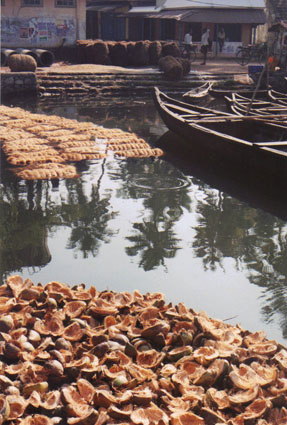Tri-City Herald, Sunday, May 21, 2006
Indians Call Them Heavenly Trees
©2006 Valerie Kreutzer
 During travels through southern India, we often stopped the van in villages to buy fresh coconuts. Peddlers would stand by a pile of the green fruit and swiftly chop off the top with their machetes. They’d insert a straw into the small opening and offer the fruit in exchange for fifteen cents.
During travels through southern India, we often stopped the van in villages to buy fresh coconuts. Peddlers would stand by a pile of the green fruit and swiftly chop off the top with their machetes. They’d insert a straw into the small opening and offer the fruit in exchange for fifteen cents.
The coconut’s sweet water was refreshing. Its medicinal properties also prevent diarrhea we learned. (Perhaps that’s why no one in our group got sick during a four-week journey, despite dire predictions and a suitcase full of medicine.)
Once empty, we asked the peddler to cut the fruit open to scoop out its succulent white flesh. Finally, we threw our shells onto a heap, but that was not the end of the coconut.
During a cruise through India’s Backwaters, we noticed islands of coconut shells floating in the water. It takes a few months before the nut’s outer shell has deteriorated, explained our cook Josh. Then the fiber can be detached and spun into a myriad of uses, including ropes, nets, mattresses, and mats.
In a village along the way we observed three women spinning rope. They stood in a triangle, one feeding fiber from a pouch around her waist, one guiding the thread, and a third turning the wheel. With a welcoming wave, the woman in charge invited me to join the process and for a few minutes I held the spindle, anxious not to break the thread. Later we noticed that coconut ropes held the canopy of our houseboat and provided the weave for huge fishing nets at sea.
From top to bottom, the coconut palm yields with abundance. Its roots are used for Ayurvedic healing, its wood builds homes and boats, its branches cover roofs, and the oil extracted from its flesh gives the brilliant shine to every Indian woman’s thick black hair.
Offerings at temples to the elephant-headed Ganesh who is believed to remove obstacles, include half shells of coconuts because the god considers them a treat. So does the live elephant that guards the gate of many Hindu temples. With its mighty foot it cracks the shell, scooping the meat with its trunk.
In the southern state of Kerala, coconut palms dominate the coastal skyline and cover thousands of acres. They make India one of the world’s top producers of palm products. Indians call them ‘trees of heaven.’ And swinging in a hammock by the sea, looking at the palms’ swaying crowns, you’re soon convinced that the locals got it right.
